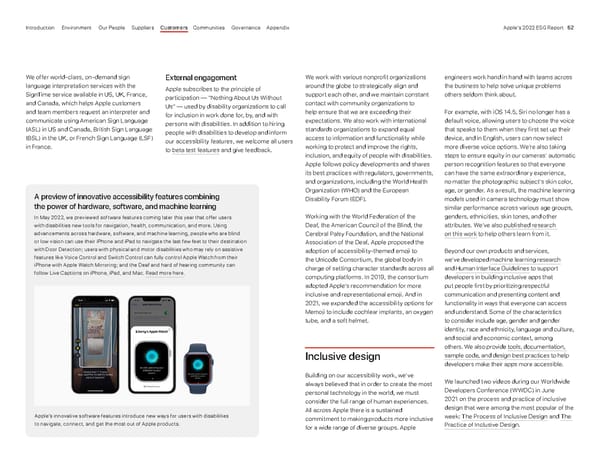We offer world-class, on-demand sign language interpretation services with the SignTime service available in US, UK, France, and Canada, which helps Apple customers and team members request an interpreter and communicate using American Sign Language (ASL) in US and Canada, British Sign Language (BSL) in the UK, or French Sign Language (LSF) in France. External engagement Apple subscribes to the principle of participation — “Nothing About Us Without Us” — used by disability organizations to call for inclusion in work done for, by, and with persons with disabilities. In addition to hiring people with disabilities to develop and inform our accessibility features, we welcome all users to beta test features and give feedback. We work with various nonprofit organizations around the globe to strategically align and support each other, and we maintain constant contact with community organizations to help ensure that we are exceeding their expectations. We also work with international standards organizations to expand equal access to information and functionality while working to protect and improve the rights, inclusion, and equity of people with disabilities. Apple follows policy developments and shares its best practices with regulators, governments, and organizations, including the World Health Organization (WHO) and the European Disability Forum (EDF). Working with the World Federation of the Deaf, the American Council of the Blind, the Cerebral Palsy Foundation, and the National Association of the Deaf, Apple proposed the adoption of accessibility-themed emoji to the Unicode Consortium, the global body in charge of setting character standards across all computing platforms. In 2019, the consortium adopted Apple’s recommendation for more inclusive and representational emoji. And in 2021, we expanded the accessibility options for Memoji to include cochlear implants, an oxygen tube, and a soft helmet. Inclusive design Building on our accessibility work, we’ve always believed that in order to create the most personal technology in the world, we must consider the full range of human experiences. All across Apple there is a sustained commitment to making products more inclusive for a wide range of diverse groups. Apple engineers work hand in hand with teams across the business to help solve unique problems others seldom think about. For example, with iOS 14.5, Siri no longer has a default voice, allowing users to choose the voice that speaks to them when they first set up their device, and in English, users can now select more diverse voice options. We’re also taking steps to ensure equity in our cameras’ automatic person recognition features so that everyone can have the same extraordinary experience, no matter the photographic subject’s skin color, age, or gender. As a result, the machine learning models used in camera technology must show similar performance across various age groups, genders, ethnicities, skin tones, and other attributes. We’ve also published research on this work to help others learn from it. Beyond our own products and services, we’ve developed machine learning research and Human Interface Guidelines to support developers in building inclusive apps that put people first by prioritizing respectful communication and presenting content and functionality in ways that everyone can access and understand. Some of the characteristics to consider include age, gender and gender identity, race and ethnicity, language and culture, and social and economic context, among others. We also provide tools, documentation, sample code, and design best practices to help developers make their apps more accessible. We launched two videos during our Worldwide Developers Conference (WWDC) in June 2021 on the process and practice of inclusive design that were among the most popular of the week: The Process of Inclusive Design and The Practice of Inclusive Design . A preview of innovative accessibility features combining the power of hardware, software, and machine learning In May 2022, we previewed software features coming later this year that offer users with disabilities new tools for navigation, health, communication, and more. Using advancements across hardware, software, and machine learning, people who are blind or low vision can use their iPhone and iPad to navigate the last few feet to their destination with Door Detection; users with physical and motor disabilities who may rely on assistive features like Voice Control and Switch Control can fully control Apple Watch from their iPhone with Apple Watch Mirroring; and the Deaf and hard of hearing community can follow Live Captions on iPhone, iPad, and Mac. Read more here . Apple’s innovative software features introduce new ways for users with disabilities to navigate, connect, and get the most out of Apple products. Appendix Governance Communities Suppliers Customers Our People Environment Introduction Apple’s 2022 ESG Report 52
 ESG Report | Apple Page 51 Page 53
ESG Report | Apple Page 51 Page 53